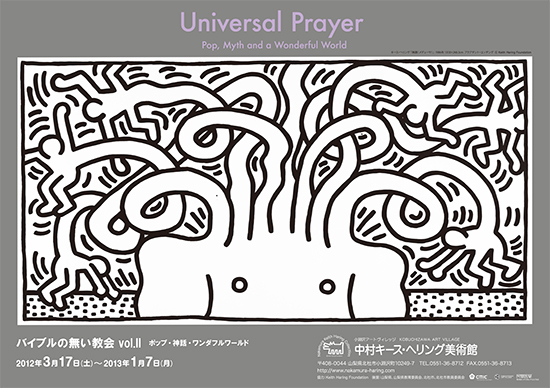In the 1980s, while Japan was booming with the bubble economy, New York City had a grim atmosphere. It’s economy was on the upswing compared to the 70s, but the quality of life was still below average and there was a problem with crime, as well as friction between races and discrimination towards the LGBT community. But this was also when a distinct new York City culture was formed. Street cultures were on the rise, with break dancing and graffiti giving birth to stars such as Warhol, Basquiat, and Madonna. Keith Haring arrived in New York in 1978, and it goes without saying that the cultural atmosphere of the city greatly influenced the 20 year-old aspiring artist. As Keith wrote in his diary on October 14th, 1978, “Everything is constantly changing. Every second from birth is spent experiencing; different sensations, different interjections, different directional vectors of force/energy constantly composing and recomposing themselves around you.”
“Universal Prayer 2012 – Pop, Myth and a Wonderful World” will focus on Keith’s artwork that dealt with pop culture as an effect of rapid consumerism under hyper-capitalism (art and commercialism), idolization (life and death), and emancipation and freedom of the self (hope towards the future). The exhibit will feature the “Slope towards Darkness,” an area which features drawings by Keith that evoke a Jomon design, the “Room for Thinking” which features subway drawings, the “Space of Idols” which features the “Icon” series and Keith’s collaboration with Andy Warhol , the “Andy Mouse” series (the first time all four have been collected together in Japan), the “Room of Hope” which features a new acquisition “Medusa” and the “Apocalypse” series as well as large scale sculptural pieces, and the “Gallery of Freedom” which features a rotation of artworks by the staff curators.

Universal Prayer | Pop, Myth and a Wonderful World
March 17th, 2012 – January 7th, 2013
Special Thanks:
Keith Haring Foundation
Nicholas Kirkwood Studio
Supported by
Yamanashi Prefecture
Yamanashi Board of Education
Hokuto City
Hokuto City Board of Education

Medical Principle Co., Ltd.